
Last spring, I bought three pots of ‘Blushing Butterflies’ gaura (Gaura lindheimeri ‘Blushing Butterflies’, 24 x 18 inches / 60 x 45 cm, Zone 6), a compact cultivar with clouds of soft pink flowers and darker stamens. This short, bushy plant has a long blooming season, more flowers than foliage and is perfect for containers. Gaura is borderline hardy in my Zone 6a garden, and has never survived when left in the ground over winter. However, in the usual spring chaos, the gaura plants ended up in the front garden bed, where they disappeared behind a large peony clump.
I had forgotten about the gaura (out of sight, out of mind), until I noticed an unusual stand of something yellow, not a chrysanthemum. The yellow flowers turned out to be Golden Baby goldenrod (Solidago ‘Goldkind’, 24 x 24 inches / 60 x 60 cm, Zone 3), another plant I had forgotten about (where is my mind?), and making a sweet marriage with the neighbouring gaura. They’re so pretty together! I removed the peony foliage so this lovely combination can be seen.
Sometimes goldenrod is the plant we love to hate, only because there’s so much of it. My back garden is looking like Golden Acres, because I didn’t weed out the usual bushel baskets of Canada goldenrod that spread through the beds. The native wild plant is vigorous, with a colonizing root system almost identical to that found of the legendary dog-strangling vine (Cynanchum rossicum), also wandering around here.
It’s a good thing that plant breeders gave their attention to developing well-behaved goldenrod cultivars, because they’re useful plants to have in mid-autumn when there are little more than mums in the garden. The hybrid goldenrods are shorter with more stylized flower wands and, thankfully, the spreading root systems have been tamed. I’ve also grown ‘Fireworks’ (S. rugosa ‘Fireworks’, 36 x 24 inches / 90 x 60 cm, Zone 4), which has bright yellow wands on sturdy stems with an attractive architectural profile. Next year I’d like to find a pot or two of ‘Crown of Rays’ (S. ‘Crown of Rays’, 24 x 18 inches / 60 x 45 cm, Zone 3), a bushy plant with large dense flower wands. ‘Crown of Rays’ was developed for the floral trade, and has the largest of all hybrid goldenrod flowers. All these (and more) are bright yellow, long blooming, and reliably hardy. They don’t mind the heat and humidity of summer, and bloom from late summer through late autumn. Thankfully, they’re clump forming, and won’t run from here to kingdom come!









Glad to see you sharing the goldenrod love, Judith. One thing I would like to add: goldenrods, especially the wild ones, are very good pollinator plants for our bees, butterflies and other pollinators. Also, since goldenrod is pollinated by bees, etc, it is NOT the cause of people’s allergies–it’s a heavy pollen, not airborne, but flowers at the same time as ragweed. I know you know that but I like to spread the word, always.
I saw ‘Fireworks’ goldenrod at Powell Gardens in Kansas City, Missouri, a few years ago, and have wanted it ever since.
Hello: I would like to see a picture of the Gaura and the Goldenrod together. If two plants are mentioned it’s nice to see both. I live near Stouffville and this year everything in my garden is gigantic. I have 6′ Cleomes and 5′ Lavateras and they’ve both been blooming since July. Gail
Hi Gail,
Wish I could have gotten a picture to show you, but unfortunately, the photographer isn’t always here at just the right moment. But take my word for it, gaura and hybrid goldenrod are a good match! Hope you can try them in your garden.
Yes, everything is tall and gigantic with all the rain we’ve had. It’s interesting and surprising to see the growth potential when lots of water is available.
– Judith